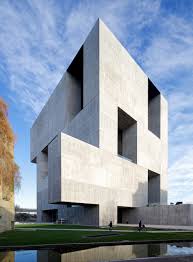Questions or Answers?

Question or answer?
Which is more important: questions or answers?
Being a good systems thinker, I used to think the answer was obvious: answers are more important than questions. You’re given a problem, you pull it apart into its subsystems, you analyze them, and you develop solutions.
But what if you’re analyzing the wrong problem?
I thought about this yesterday when I read a profile of Alejandro Aravena, the Chilean architect who just won the Pritzker Prize. Aravena and his colleagues – as you might imagine – develop some very creative ideas. They do so by focusing on questions rather than answers. (Aravena’s building at the Universidad Católica de Chile is pictured).
In 2010, for instance, Aravena’s firm, Elemental, was selected to help rebuild the city of Constitución after it was hit by an earthquake and tsunami. I would have thought that they would focus on the built environment – buildings, infrastructure, and so on. They’re architects, after all. Isn’t that what architects do?
But Aravena explains it differently:
“We asked the community to identify not the answer, but what was the question,” Mr. Aravena said. This, it turned out, was how to manage rainfall, so the firm designed a forest that could help prevent flooding.
Architects, then, designed a forest instead of a building. If they were thinking about answers rather than questions, they might have missed this altogether.
On a smaller scale, I had a similar experience early in my career when I worked for Solbourne Computer. We build very fast computers – in 1988, Electronics magazine named our high-end machine the computer of the year. Naturally, we positioned our messages around speed, advanced technology, and throughput.
But our early customers were actually buying something else. When we interviewed our first dozen customers, we found that they were all men, in their early thirties, and that they had recently been promoted to replace an executive who had been in place for many years. They bought our computers to mark the changeover from the old regime to the new regime. They were meeting a sociological need as much as a technical need.
When you go to a gas station to fill your car’s tank, you may imagine that you’re buying gasoline. But, as the marketing guru Ted Levitt pointed out long ago, you’re really buying the right to continue driving your car. It’s a different question and a broader perspective and may well lead you to more creative ways to continue driving.
More recently, another marketing guru, Daniel Pink, wrote that products and services “… are far more valuable when your prospect is mistaken, confused or completely clueless about their true problem.” So often our market research focuses on simple questions about obvious problems. The classic question is, “What keeps you up at night?” We identify an obvious problem and then propose a solution. Meanwhile, our competitors are identifying the same problem and proposing their solutions. We’re locked into the same problem space.
But if we step back, look around, dig a little deeper, observe more creatively, and ask non-obvious questions, we may find that the customer actually needs something completely different. Different than what they imagined – or we imagined or our competitors imagined. They may, in fact, need a forest not a building.